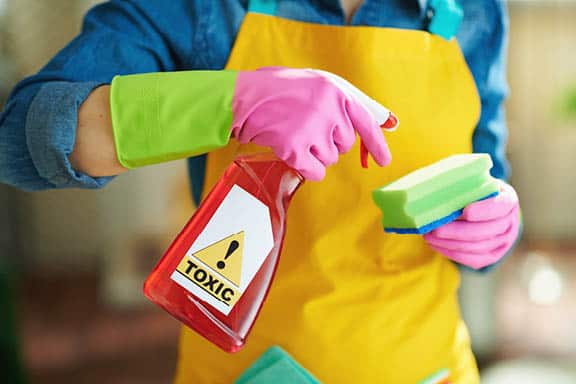What does “clean” smell like? Most people may instinctively think of the smell of chemical heavy products like bleach. While scents like “Linen Fresh” and “Ocean Breeze” sound harmless on paper, chemical cleaning products with artificial fragrances have been found by national health leaders (such as the National Library of Medicine) to be dangerous to the surrounding environment and people inside it – potentially thwarting a facility’s efforts to be green or providing a harmful effect to people’s health. Choosing the right products for a facility’s cleaning protocol is always an important decision and understanding that there are some potentially problematic elements of artificial fragrances may be a surprise. Here’s what you should consider when weighing the options between artificially fragrant and non-scented products:
Beware of Allergens
The smells detected in traditional cleaning products are either chemicals that can make preexisting allergies worse or artificially imposed scents to cover up the chemical scent. Some of these commonly found chemicals in fragrant cleaning agents can include:
- Ammonia – found in bathroom and window cleaners. Direct contact with this chemical can result in severe skin irritation, eye burning, and even permanent eye damage if not washed out immediately. The fumes of ammonia can cause nose inflammation and exasperate asthma. As a result, the Environmental Protection Agency (EPA) has classified this chemical as an extremely hazardous substance.
- Bleach – one of the most widely used cleaning agents. Many people think of bleach when associating the smell of “clean” with a name. Countless types of products contain bleach, some with and without chlorine. Bleach can cause serious burns if exposed directly to skin, and the overwhelming fumes from use have been observed to cause asthma-like symptoms in those exposed.
- D-Limonene – a chemical found concentrated in orange peels. This often is the chemical used to give off a citrus smell in a cleaning product. While many health benefits have been discovered in D-Limonene as a food additive, as an ingredient in cleaning agents it can be harmful. Exposure to this chemical as a fragrance has been found to result in asthma flair-ups and contact dermatitis.
Scented Hazards to Health and Indoor Air Quality

According to research from the National Institute of Environmental Health Science (NIH), fragrances in cleaning products have been associated with respiratory issues, skin irritation and rashes, and more severe reactions in small children like vomiting and bowel disruption. This is due in part to the Volatile Organic Compounds (VOCs) contained in artificial fragrances.
Aside from observable health effects on directly exposed individuals, VOCs can negatively impact indoor air quality (IAQ) within a facility, according to the EPA. CCS Facility Services discusses impacts that IAQ can have on facilities and building occupants in our post Maintaining Indoor Air Quality as Workforces Return to the Office. Additionally, some traditional chemical cleaning products have been found to contain carcinogens (substances capable of causing cancer). The University of Washington performed a study observing how harmful chemicals can spread through air vents from the use of certain laundry products. Recurrent use of these harmful substances can cause discomfort, illness, and in extreme cases even hospitalization if not understood fully and properly used in facility cleaning practices.
Smelling the Unknown
A major contributor to the danger of fragrant cleaning products is not knowing what the fragrance is made of. Artificial fragrances have been considered “trade secrets” in the industry for decades, with minimal outside oversight on research and implementation. Thousands of chemicals fall under the term “fragrance” and are not required to be individually listed on labels in the United States. The fragrance industry in the United States self-regulates under the name of the International Fragrance Association (IFRA) and provides safety standards to fragrance manufacturers on banned or restricted chemicals – but it is entirely voluntary with no official intervention by any third-party agency. With no checks and balances on the chemical makeup of these fragrances, facility management cannot fully guarantee a healthy environment for janitorial staff or building occupants directly exposed to these products.
The Green Solution
Switching to an eco-friendly alternative for cleaning products delivers a host of benefits for both the environment and facility occupants. Green products have been found to be exceptional replacements – or enhancements – to any facility’s supply closet. While green products may not deliver a scent of “Lavender Fields,” product ingredients are transparent. The EPA manages a certification program called Safer Choice, where products are labeled to signify whether they carry ingredients that are safer for individual and environmental health. In addition, partnering with the right commercial cleaning provider can be an effective step in switching to healthier cleaning practices and ensuring the safest products are used. Commercial cleaners such as CCS Facility Services can earn accreditation from organizations such as the U.S. Green Building Council that aim to provide solutions and resources for sustainable cleaning.
CCS Facility Services is proud to be a leader in sustainability in the commercial cleaning space, and, in fact, being green isn’t just in our business practices, it’s in our logo! To learn more about CCS’ commitment to an excellent, environmentally healthy clean, visit our Sustainability page.

